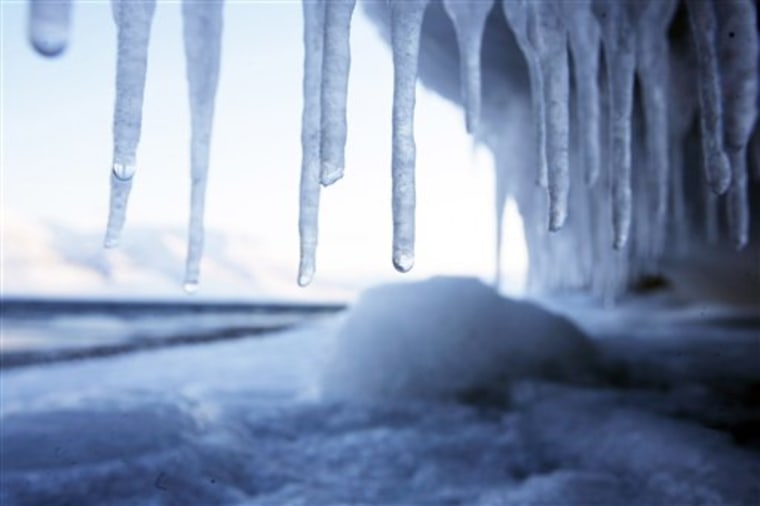Icebreakers sit idle in ports. Insects crawl out of forest hideouts. Daffodils sprout up from green lawns.
Winter ended before it started in Europe's north, where record-high temperatures have people wondering whether it's a fluke or an ominous sign of a warming world.
"It's the warmest winter ever" recorded, said John Ekwall of the Swedish Meteorological and Hydrological Institute.
In December, January and February, the average temperature in Stockholm was 36 degrees — the highest on record since record-keeping began in 1756.
Record winter highs were set at 12 other locations across the country, according to the national weather service, SMHI.
Across the Baltic Sea, Latvia and most of Finland reported the warmest winter since 1925.
Latvia saw an average temperature of about 33 degrees, nine degrees above normal, according to the national meteorological agency.
Southern Finland had only 20 days of snow, compared to 70 days normally, while neighboring Estonia had to cancel a popular cross-country ski marathon in the southern city of Tartu in early February.
"I don't remember winter like this. We had almost no snow at all in February," said Merike Merilain, chief weather forecaster at Estonia's meteorological institute, EMHI.
"It's been emotionally very stressful, especially to many older people, that it's dark and rainy all the time," she added.
In Norway, the average temperature in February was the second highest on record, 8 degrees above normal.
Experts are careful not to blame global warming, noting that a warm winter could be followed by a cold one.
Warm Atlantic surface temps cited
The Finnish Meteorological Institute said the mild winter partly resulted from strong southerly and westerly air currents caused by exceptionally warm surface temperatures of the Atlantic.
Nevertheless, the higher temperatures have only fueled concern that greenhouse gasses are changing the climate, especially in the sensitive Arctic region.
"When we were young, back in the '80s, then winter existed," said Ronny Ahlstedt, 28, who works at an outdoor ice-skating rink in downtown Stockholm. "We are contributing to this warm weather by letting out all this pollution in the air."
In areas normally covered in snow and ice, spring-like temperatures have brought premature sightings of flowers such as winter aconite, snowdrops, wood anemone, daffodils and coltsfoot.
Migratory birds have returned from southern latitudes prematurely. In southern Sweden, they never left.
"The birds that have stayed are robins and chaffinches," said biologist Lars-Ake Janzon at the Swedish Museum of Natural History. "They stayed because there hasn't been any snow."
The warm weather also has stirred life inside the vast forests of the Nordic and Baltic countries, where insects such as ants and ticks emerged early from winter shelter.
For businesses, the mild weather has been a mixed blessing.
In Lithuania, logging companies say many dirt roads were impassable because they were thick with mud instead of frozen, leaving timber rotting in the damp forests.
The express ferries between Tallinn and Helsinki, however, have benefited from the lack of ice in the Gulf of Finland. Normally they are unable to operate from late December to April, but this year some of them have been running almost without interruptions.
Both Finland and Sweden have left most of their icebreakers in port.
Finland's coasts are clear of ice up to 350 miles north of Helsinki, said Jouni Vainio from the Finnish Institute of Marine Research. "It's most unusual because now the whole sea should be frozen along the Finnish coast."
Railway traffic is also being helped by the warmth. More than 90 percent of all trains this winter have been on time or less than five minutes late, according to the Finnish state railway, VR.
"Hard frosts and heavy blizzards have always been a bane of rail traffic. This winter has been punctuated by their absence," VR spokesman Herbert Mannerstrom said.
For winter sports enthusiasts, the green winter has been a nightmare. Small ski resorts around Stockholm never opened, and skating enthusiasts waited in vain for ice to form on the waterways surrounding the Swedish capital.
"There's not one millimeter of ice," said Anders Tysk, organizer of the annual Vikingarannet ice-skating race on Lake Malaren. After postponing the race several weekends, he had to tell 500 registered participants on Monday there would be no race this year.
"It's the first time we've canceled since we introduced flexible dates in 2003," he said.
While Europe's north has been unseasonably warm, the west has been sunny and dry.
The French weather service, Meteo France, announced in a preliminary report Friday that France had not had such a sunny winter since 1950.
In Portugal, rainfall from September to January was the lowest for 91 years.
The cold, however, is making a late comeback in some areas.
All of Finland is blanketed in snow, and forecasts predict at least another week of wintry weather with heavy blizzards and frost. That news delighted a group of six-grade boys traveling by train for a snowboard outing Tuesday with their teacher in Helsinki.
"It's been a long time coming. It's only the second time this year that we've been able to get out there," said 13-year-old Timo, who only gave his first name.
